while driving VOLKSWAGEN UP! 2021 Owner´s Manual
[x] Cancel search | Manufacturer: VOLKSWAGEN, Model Year: 2021, Model line: UP!, Model: VOLKSWAGEN UP! 2021Pages: 211, PDF Size: 5.98 MB
Page 80 of 211
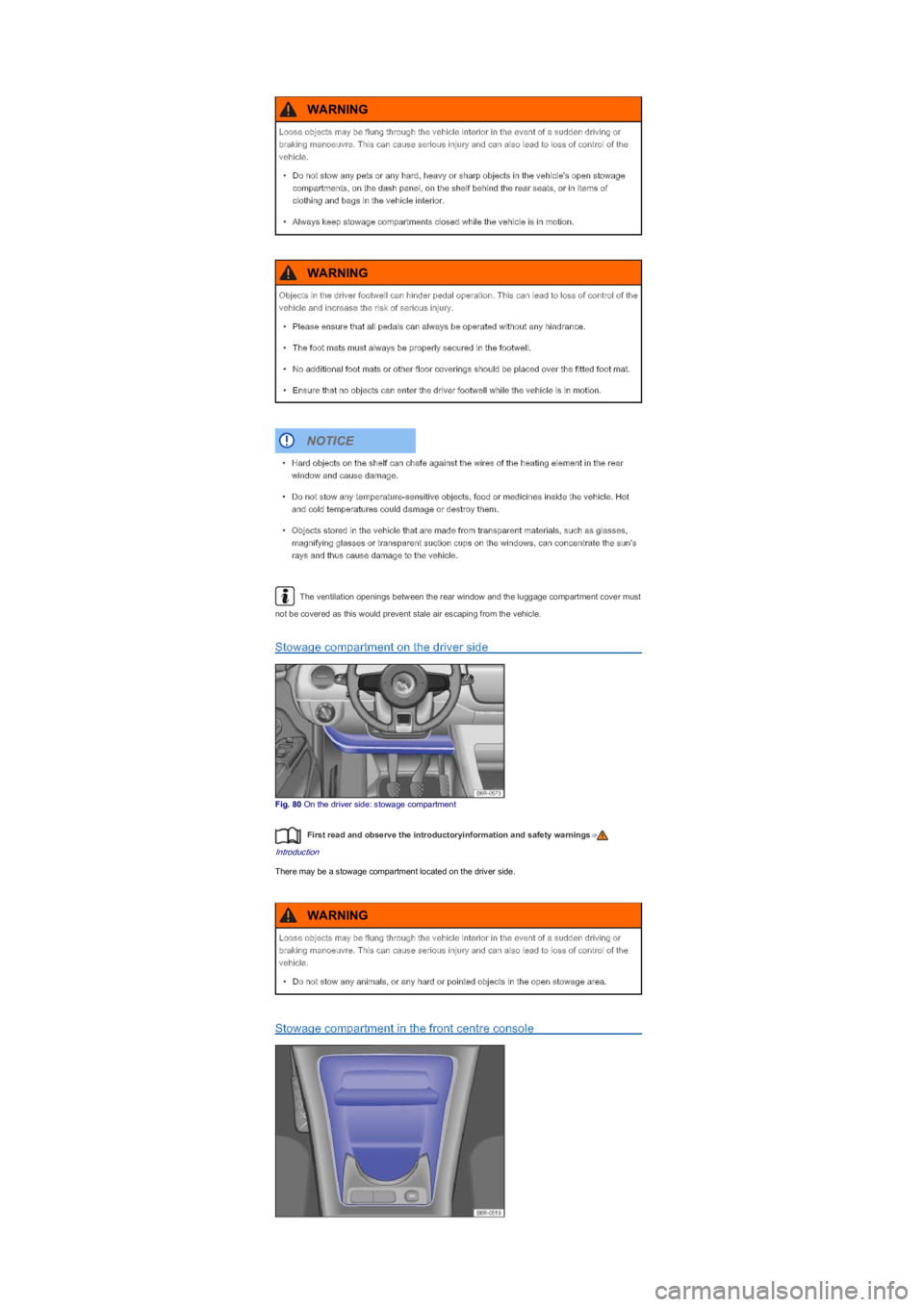
The ventilation openings between the rear window and the luggage compartment cover must
not be covered as this would prevent stale air escaping from the vehicle.
Stowage compartment on the driver side
Fig. 80 On the driver side: stowage compartment
First read and observe the introductoryinformation and safety warnings⇒
Introduction
There may be a stowage compartment located on the driver side.
Stowage compartment in the front centre console
Loose objects may be flung through the vehicle interior in the event of a sudden driving or
braking manoeuvre. This can cause serious injury and can also lead to loss of control of the
vehicle.
•Do not stow any pets or any hard, heavy or sharp objects in the vehicle's open stowage
compartments, on the dash panel, on the shelf behind the rear seats, or in items of
clothing and bags in the vehicle interior.
•Always keep stowage compartments closed while the vehicle is in motion.
WARNING
Objects in the driver footwell can hinder pedal operation. This can lead to loss of control of the
vehicle and increase the risk of serious injury.
•Please ensure that all pedals can always be operated without any hindrance.
•The foot mats must always be properly secured in the footwell.
•No additional foot mats or other floor coverings should be placed over the fitted foot mat.
•Ensure that no objects can enter the driver footwell while the vehicle is in motion.
WARNING
•Hard objects on the shelf can chafe against the wires of the heating element in the rear
window and cause damage.
•Do not stow any temperature-sensitive objects, food or medicines inside the vehicle. Hot
and cold temperatures could damage or destroy them.
•Objects stored in the vehicle that are made from transparent materials, such as glasses,
magnifying glasses or transparent suction cups on the windows, can concentrate the sun's
rays and thus cause damage to the vehicle.
NOTICE
Loose objects may be flung through the vehicle interior in the event of a sudden driving or
braking manoeuvre. This can cause serious injury and can also lead to loss of control of the
vehicle.
•Do not stow any animals, or any hard or pointed objects in the open stowage area.
WARNING
Page 81 of 211
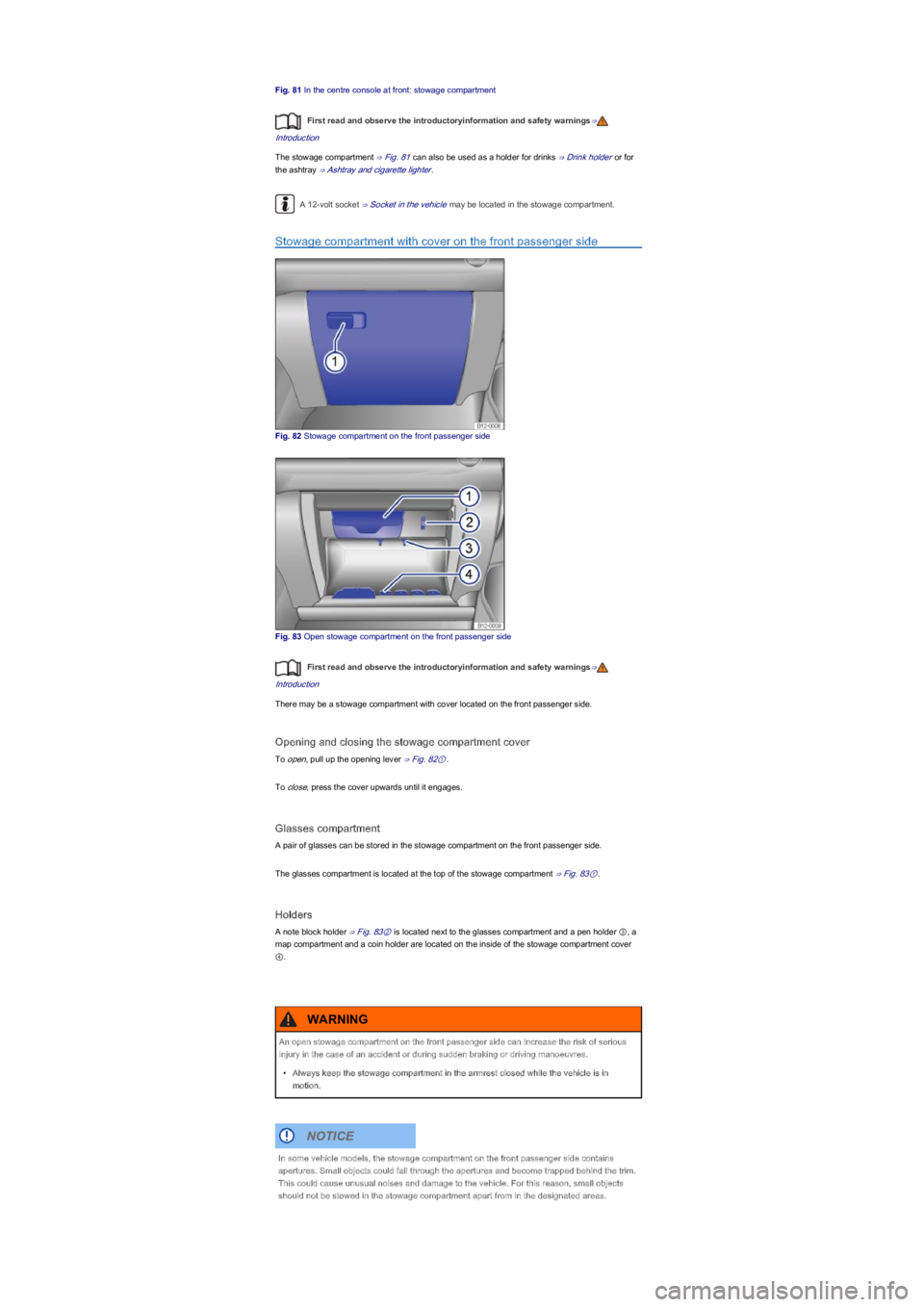
Fig. 81 In the centre console at front: stowage compartment
First read and observe the introductoryinformation and safety warnings⇒
Introduction
The stowage compartment ⇒ Fig. 81 can also be used as a holder for drinks ⇒ Drink holder or for
the ashtray ⇒ Ashtray and cigarette lighter.
A 12-volt socket ⇒ Socket in the vehicle may be located in the stowage compartment.
Stowage compartment with cover on the front passenger side
Fig. 82 Stowage compartment on the front passenger side
Fig. 83 Open stowage compartment on the front passenger side
First read and observe the introductoryinformation and safety warnings⇒
Introduction
There may be a stowage compartment with cover located on the front passenger side.
Opening and closing the stowage compartment cover
To open, pull up the opening lever ⇒ Fig. 82①.
To close, press the cover upwards until it engages.
Glasses compartment
A pair of glasses can be stored in the stowage compartment on the front passenger side.
The glasses compartment is located at the top of the stowage compartment ⇒ Fig. 83①.
Holders
A note block holder ⇒ Fig. 83② is located next to the glasses compartment and a pen holder ③, a
map compartment and a coin holder are located on the inside of the stowage compartment cover
④.
An open stowage compartment on the front passenger side can increase the risk of serious
injury in the case of an accident or during sudden braking or driving manoeuvres.
•Always keep the stowage compartment in the armrest closed while the vehicle is in
motion.
WARNING
In some vehicle models, the stowage compartment on the front passenger side contains
apertures. Small objects could fall through the apertures and become trapped behind the trim.
This could cause unusual noises and damage to the vehicle. For this reason, small objects
should not be stowed in the stowage compartment apart from in the designated areas.
NOTICE
Page 87 of 211
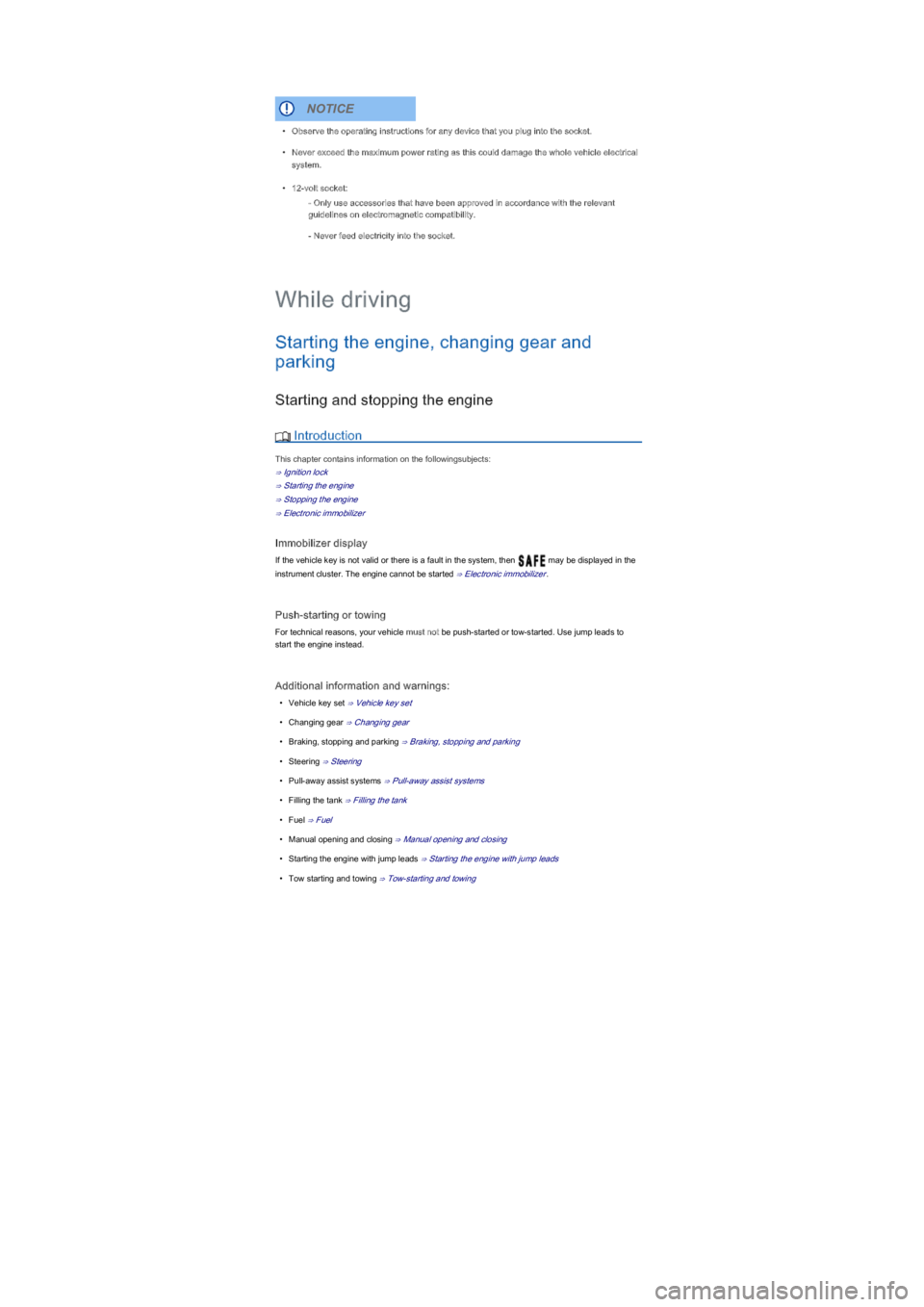
Starting the engine, changing gear and
parking
Starting and stopping the engine
Introduction
This chapter contains information on the followingsubjects:
⇒ Ignition lock
⇒ Starting the engine
⇒ Stopping the engine
⇒ Electronic immobilizer
Immobilizer display
If the vehicle key is not valid or there is a fault in the system, then may be displayed in the
instrument cluster. The engine cannot be started ⇒ Electronic immobilizer.
Push-starting or towing
For technical reasons, your vehicle must not be push-started or tow-started. Use jump leads to
start the engine instead.
Additional information and warnings:
•Vehicle key set ⇒ Vehicle key set
•Changing gear ⇒ Changing gear
•Braking, stopping and parking ⇒ Braking, stopping and parking
•Steering ⇒ Steering
•Pull-away assist systems ⇒ Pull-away assist systems
•Filling the tank ⇒ Filling the tank
•Fuel ⇒ Fuel
•Manual opening and closing ⇒ Manual opening and closing
•Starting the engine with jump leads ⇒ Starting the engine with jump leads
•Tow starting and towing ⇒ Tow-starting and towing
•Observe the operating instructions for any device that you plug into the socket.
•Never exceed the maximum power rating as this could damage the whole vehicle electrical
system.
•12-volt socket:
- Only use accessories that have been approved in accordance with the relevant
guidelines on electromagnetic compatibility.
- Never feed electricity into the socket.
NOTICE
While driving
Page 89 of 211
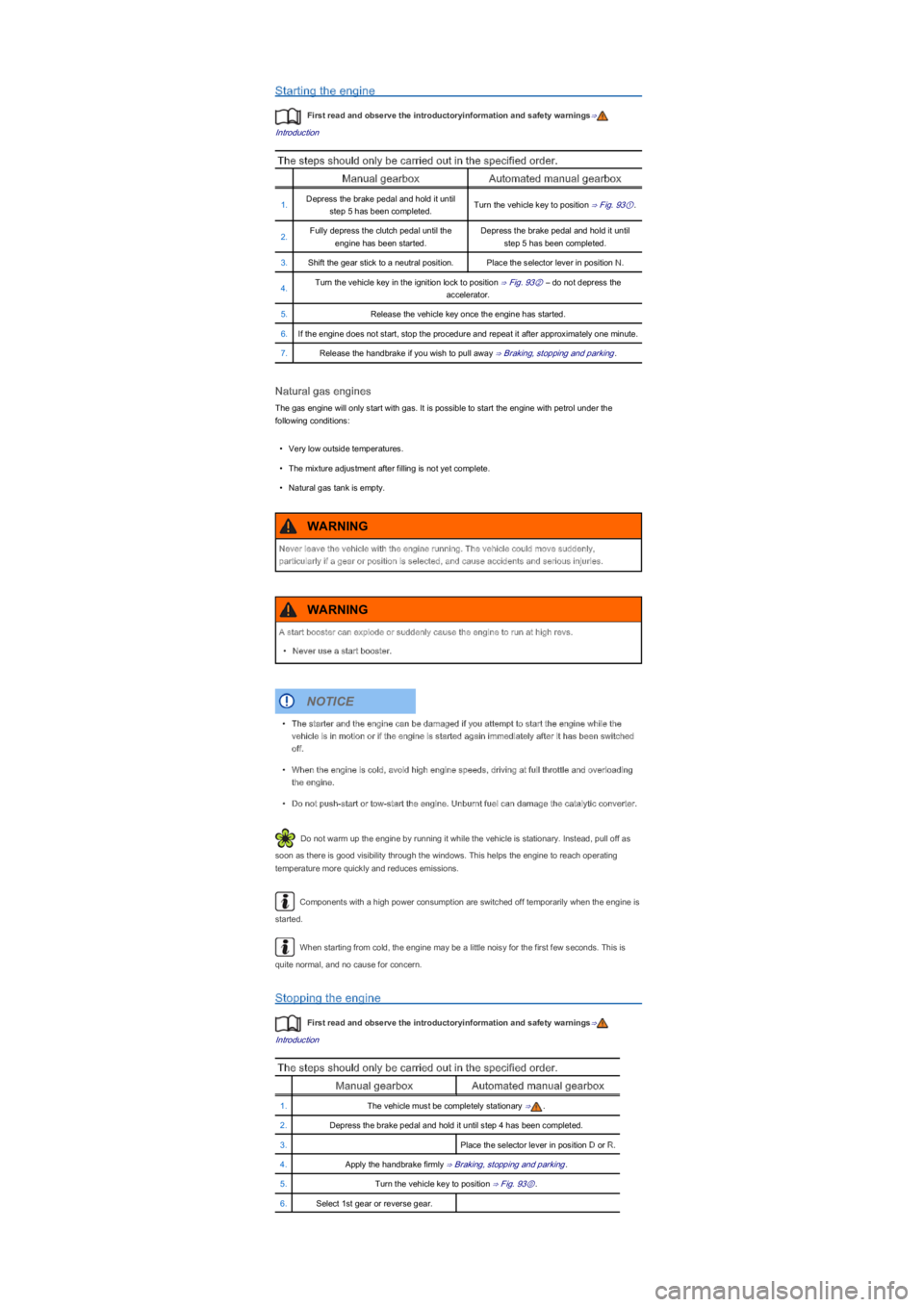
Starting the engine
First read and observe the introductoryinformation and safety warnings⇒
Introduction
The steps should only be carried out in the specified order.
Manual gearboxAutomated manual gearbox
1.Depress the brake pedal and hold it until
step 5 has been completed.Turn the vehicle key to position ⇒ Fig. 93①.
2.Fully depress the clutch pedal until the
engine has been started.
Depress the brake pedal and hold it until
step 5 has been completed.
3.Shift the gear stick to a neutral position.Place the selector lever in position N.
4.Turn the vehicle key in the ignition lock to position ⇒ Fig. 93② – do not depress the
accelerator.
5.Release the vehicle key once the engine has started.
6.If the engine does not start, stop the procedure and repeat it after approximately one minute.
7.Release the handbrake if you wish to pull away ⇒ Braking, stopping and parking.
Natural gas engines
The gas engine will only start with gas. It is possible to start the engine with petrol under the
following conditions:
•Very low outside temperatures.
•The mixture adjustment after filling is not yet complete.
•Natural gas tank is empty.
Do not warm up the engine by running it while the vehicle is stationary. Instead, pull off as
soon as there is good visibility through the windows. This helps the engine to reach operating
temperature more quickly and reduces emissions.
Components with a high power consumption are switched off temporarily when the engine is
started.
When starting from cold, the engine may be a little noisy for the first few seconds. This is
quite normal, and no cause for concern.
Stopping the engine
First read and observe the introductoryinformation and safety warnings⇒
Introduction
The steps should only be carried out in the specified order.
Manual gearboxAutomated manual gearbox
1.The vehicle must be completely stationary ⇒.
2.Depress the brake pedal and hold it until step 4 has been completed.
3.Place the selector lever in position D or R.
4.Apply the handbrake firmly ⇒ Braking, stopping and parking.
5.Turn the vehicle key to position ⇒ Fig. 93⓪.
6.Select 1st gear or reverse gear.
Never leave the vehicle with the engine running. The vehicle could move suddenly,
particularly if a gear or position is selected, and cause accidents and serious injuries.
WARNING
A start booster can explode or suddenly cause the engine to run at high revs.
•Never use a start booster.
WARNING
•The starter and the engine can be damaged if you attempt to start the engine while the
vehicle is in motion or if the engine is started again immediately after it has been switched
off.
•When the engine is cold, avoid high engine speeds, driving at full throttle and overloading
the engine.
•Do not push-start or tow-start the engine. Unburnt fuel can damage the catalytic converter.
NOTICE
Page 90 of 211

After the engine is switched off, the radiator fan in the engine compartment may run on for
some minutes, even if the ignition is switched off or the vehicle key has been removed. The radiator
fan will switch itself off automatically.
Electronic immobilizer
First read and observe the introductoryinformation and safety warnings⇒
Introduction
The immobilizer helps to prevent the engine from being started and driven with an unauthorised
vehicle key.
There is a chip in the key. It automatically deactivates the immobilizer when the vehicle key is
inserted into the ignition lock.
The electronic immobilizer is automatically activated when the vehicle key is removed from the
ignition lock.
The engine can only be started using a genuine Volkswagen vehicle key with the correct code.
Coded vehicle keys are available from a Volkswagen dealership ⇒ Vehicle key set.
If a non-authorised vehicle key has been used, the display in the instrument cluster will show
. The vehicle cannot be used if this occurs. Remove the non-authorised vehicle key from
the ignition lock and used an authorised vehicle key.
The vehicle cannot be operated properly if you do not have a genuine Volkswagen key.
Changing gear
Introduction
This chapter contains information on the followingsubjects:
⇒ Warning and indicator lamp
⇒ Pedals
⇒ Manual gearbox: selecting a gear
⇒ Automated manual gearbox: selecting a gear
⇒ Changing gear with Tiptronic
⇒ Driving with an automated manual gearbox
⇒ Fault in the automated manual gearbox
⇒ Gear-change indicator (manual gearbox)
The following will occur if reverse gear is selected and the ignition is
switched on:
•The reverse light comes on.
•The rear window wiper will move once when the windscreen wipers are switched on.
•The ParkPilot may switch on.
Additional information and warnings:
•Overview of the centre console ⇒ Overview of the centre console
•Instruments ⇒ Instruments
•Braking, stopping and parking ⇒ Braking, stopping and parking
•Pull-away assist systems ⇒ Pull-away assist systems
•ParkPilot ⇒ ParkPilot
•Engine management system and exhaust purification system ⇒ Engine management system
and exhaust purification system
Never switch off the engine while the vehicle is in motion. This can lead to a loss of vehicle
control, accidents and serious injuries.
•The airbags and belt tensioners will not work if the ignition is switched off.
•The brake servo will not work when the engine is switched off. More force is required on
the brake pedal to stop the vehicle.
•The power steering will not function if the engine is switched off, and more force will be
required to steer the vehicle.
•If the vehicle key is removed from the ignition, the steering lock can activate and you will
no longer be able to steer the vehicle.
WARNING
If the vehicle has been driven at high load for a long period, the engine could overheat when it
is switched off. In order to avoid damage to the engine, allow the engine to run in neutral for
approximately 2 minutes before switching it off.
NOTICE
Page 93 of 211
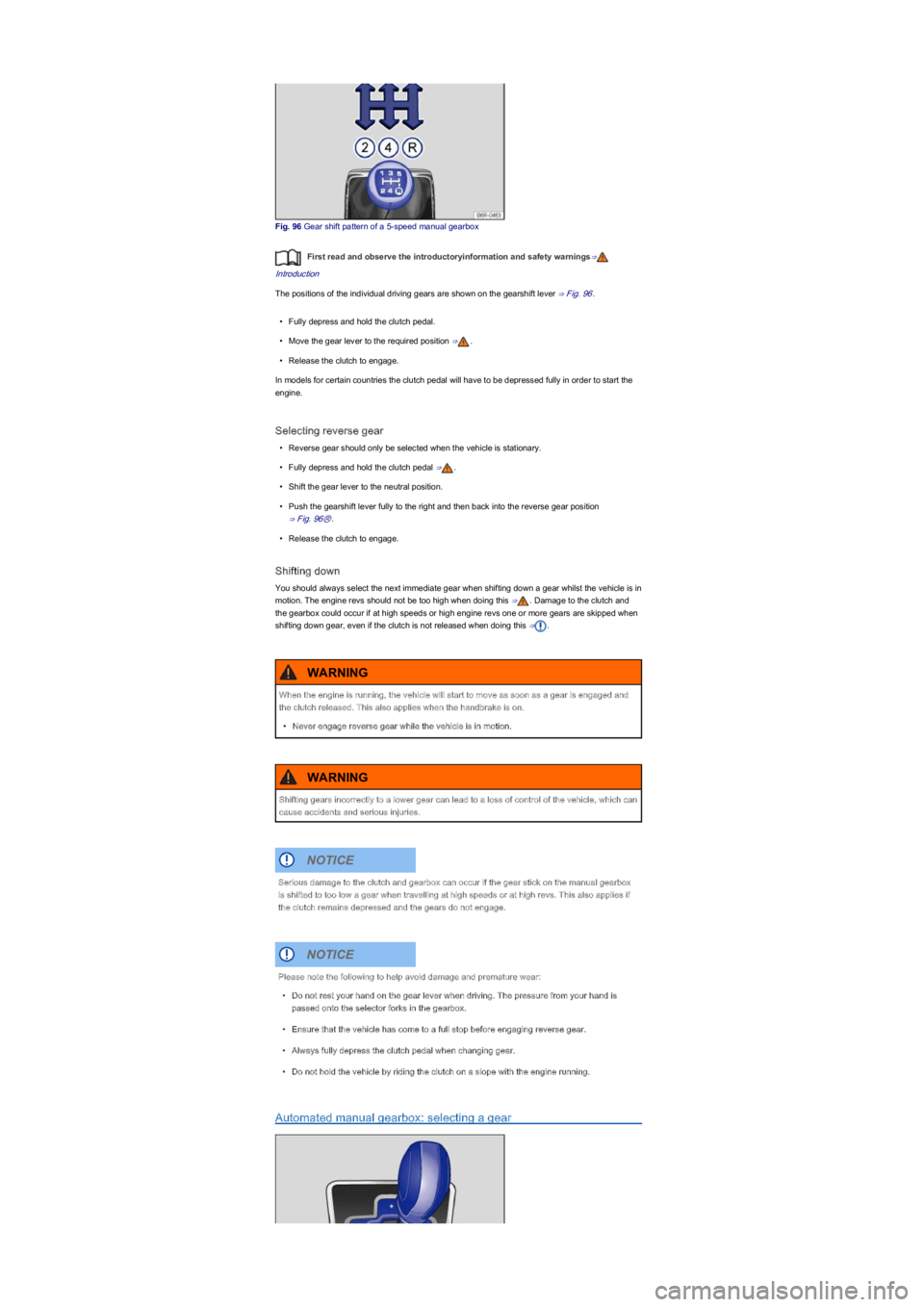
Fig. 96 Gear shift pattern of a 5-speed manual gearbox
First read and observe the introductoryinformation and safety warnings⇒
Introduction
The positions of the individual driving gears are shown on the gearshift lever ⇒ Fig. 96.
•Fully depress and hold the clutch pedal.
•Move the gear lever to the required position ⇒.
•Release the clutch to engage.
In models for certain countries the clutch pedal will have to be depressed fully in order to start the
engine.
Selecting reverse gear
•Reverse gear should only be selected when the vehicle is stationary.
•Fully depress and hold the clutch pedal ⇒.
•Shift the gear lever to the neutral position.
•Push the gearshift lever fully to the right and then back into the reverse gear position
⇒ Fig. 96Ⓡ.
•Release the clutch to engage.
Shifting down
You should always select the next immediate gear when shifting down a gear whilst the vehicle is in
motion. The engine revs should not be too high when doing this ⇒. Damage to the clutch and
the gearbox could occur if at high speeds or high engine revs one or more gears are skipped when
shifting down gear, even if the clutch is not released when doing this ⇒.
Automated manual gearbox: selecting a gear
When the engine is running, the vehicle will start to move as soon as a gear is engaged and
the clutch released. This also applies when the handbrake is on.
•Never engage reverse gear while the vehicle is in motion.
WARNING
Shifting gears incorrectly to a lower gear can lead to a loss of control of the vehicle, which can
cause accidents and serious injuries.
WARNING
Serious damage to the clutch and gearbox can occur if the gear stick on the manual gearbox
is shifted to too low a gear when travelling at high speeds or at high revs. This also applies if
the clutch remains depressed and the gears do not engage.
NOTICE
Please note the following to help avoid damage and premature wear:
•Do not rest your hand on the gear lever when driving. The pressure from your hand is
passed onto the selector forks in the gearbox.
•Ensure that the vehicle has come to a full stop before engaging reverse gear.
•Always fully depress the clutch pedal when changing gear.
•Do not hold the vehicle by riding the clutch on a slope with the engine running.
NOTICE
Page 94 of 211
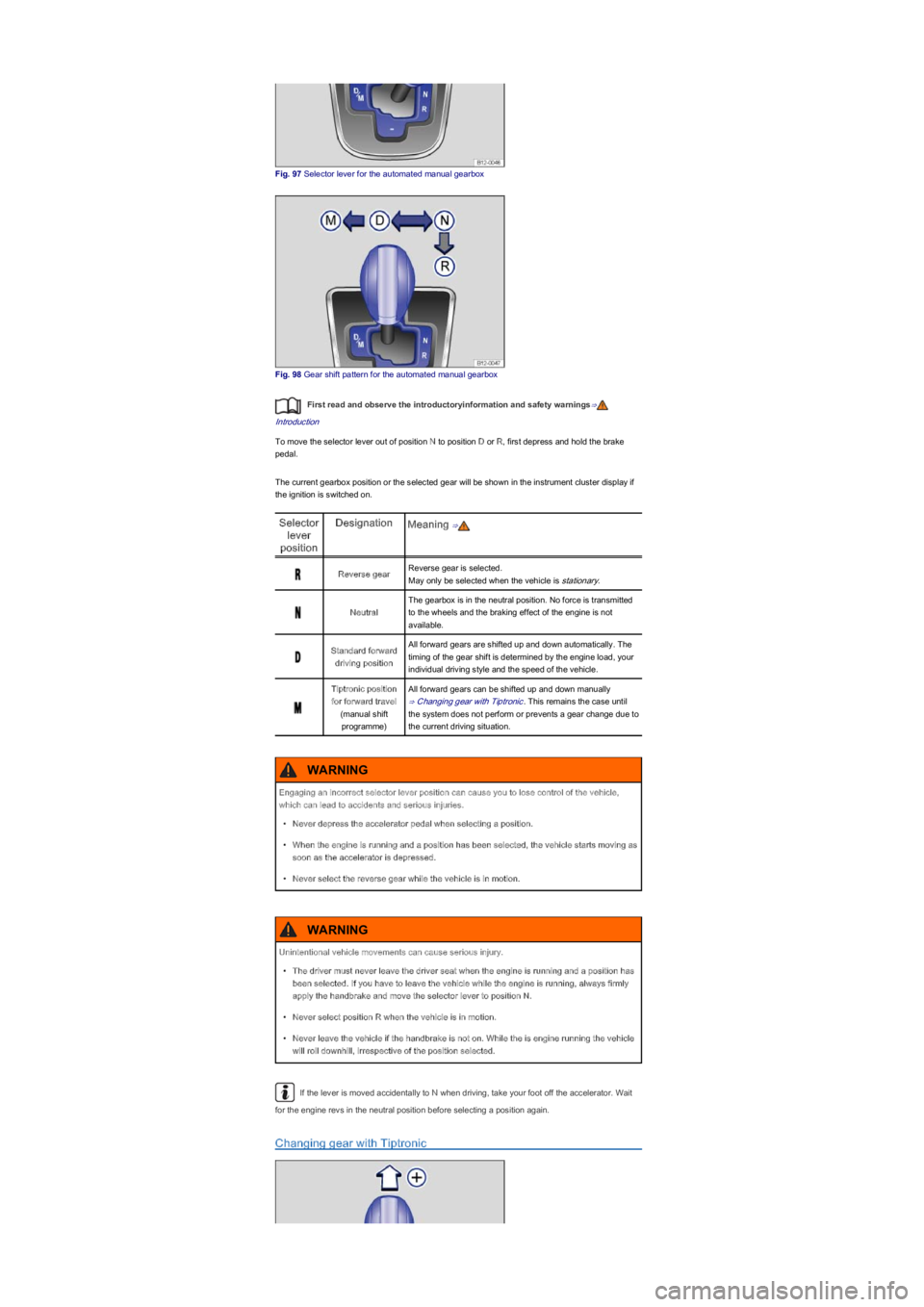
Fig. 97 Selector lever for the automated manual gearbox
Fig. 98 Gear shift pattern for the automated manual gearbox
First read and observe the introductoryinformation and safety warnings⇒
Introduction
To move the selector lever out of position N to position D or R, first depress and hold the brake
pedal.
The current gearbox position or the selected gear will be shown in the instrument cluster display if
the ignition is switched on.
Selector
lever
position
DesignationMeaning ⇒
Reverse gearReverse gear is selected.
May only be selected when the vehicle is stationary.
Neutral
The gearbox is in the neutral position. No force is transmitted
to the wheels and the braking effect of the engine is not
available.
Standard forward
driving position
All forward gears are shifted up and down automatically. The
timing of the gear shift is determined by the engine load, your
individual driving style and the speed of the vehicle.
Tiptronic position
for forward travel
(manual shift
programme)
All forward gears can be shifted up and down manually
⇒ Changing gear with Tiptronic. This remains the case until
the system does not perform or prevents a gear change due to
the current driving situation.
If the lever is moved accidentally to N when driving, take your foot off the accelerator. Wait
for the engine revs in the neutral position before selecting a position again.
Changing gear with Tiptronic
Engaging an incorrect selector lever position can cause you to lose control of the vehicle,
which can lead to accidents and serious injuries.
•Never depress the accelerator pedal when selecting a position.
•When the engine is running and a position has been selected, the vehicle starts moving as
soon as the accelerator is depressed.
•Never select the reverse gear while the vehicle is in motion.
WARNING
Unintentional vehicle movements can cause serious injury.
•The driver must never leave the driver seat when the engine is running and a position has
been selected. If you have to leave the vehicle while the engine is running, always firmly
apply the handbrake and move the selector lever to position N.
•Never select position R when the vehicle is in motion.
•Never leave the vehicle if the handbrake is not on. While the is engine running the vehicle
will roll downhill, irrespective of the position selected.
WARNING
Page 96 of 211
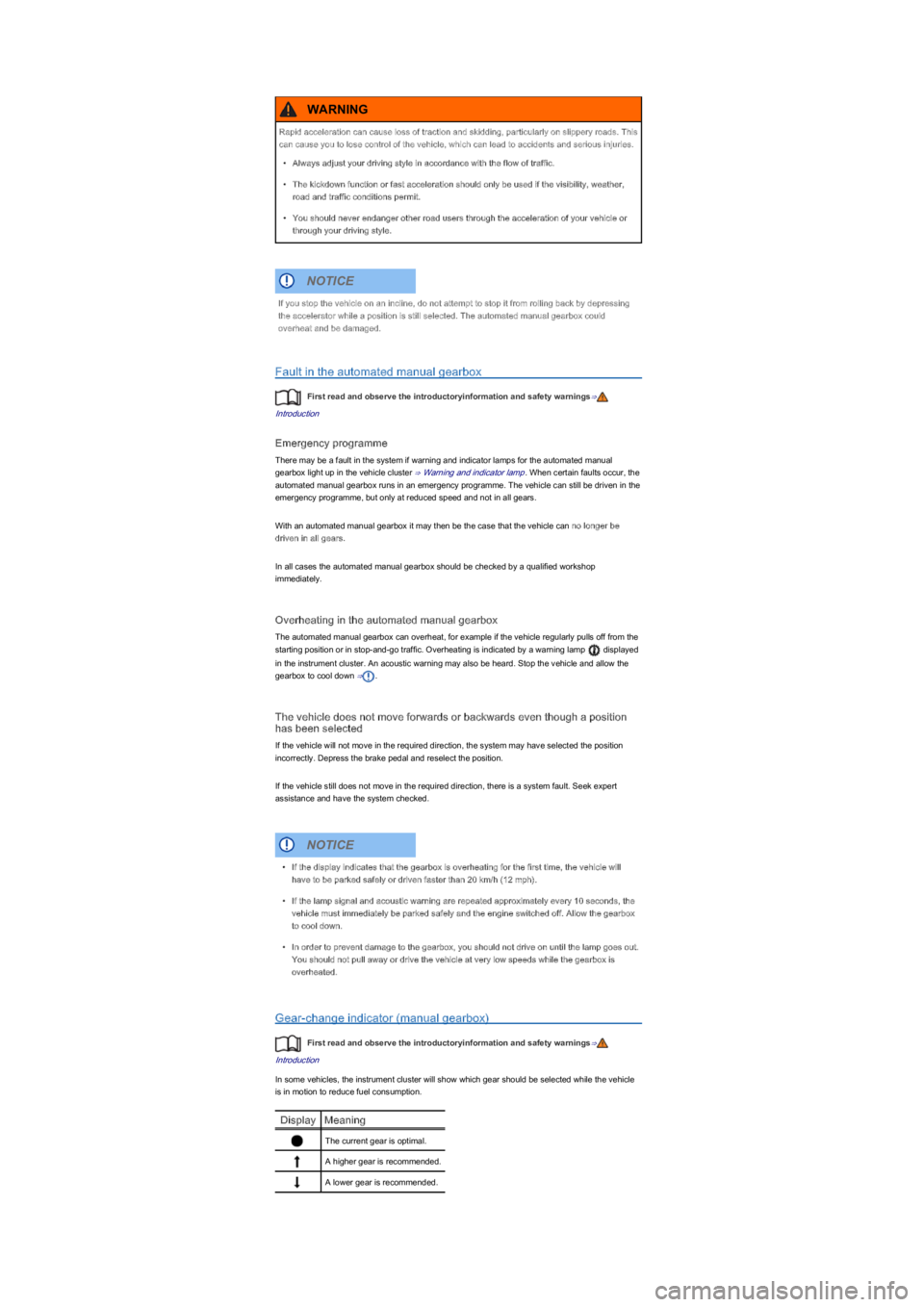
Fault in the automated manual gearbox
First read and observe the introductoryinformation and safety warnings⇒
Introduction
Emergency programme
There may be a fault in the system if warning and indicator lamps for the automated manual
gearbox light up in the vehicle cluster ⇒ Warning and indicator lamp. When certain faults occur, the
automated manual gearbox runs in an emergency programme. The vehicle can still be driven in the
emergency programme, but only at reduced speed and not in all gears.
With an automated manual gearbox it may then be the case that the vehicle can no longer be
driven in all gears.
In all cases the automated manual gearbox should be checked by a qualified workshop
immediately.
Overheating in the automated manual gearbox
The automated manual gearbox can overheat, for example if the vehicle regularly pulls off from the
starting position or in stop-and-go traffic. Overheating is indicated by a warning lamp displayed
in the instrument cluster. An acoustic warning may also be heard. Stop the vehicle and allow the
gearbox to cool down ⇒.
The vehicle does not move forwards or backwards even though a position
has been selected
If the vehicle will not move in the required direction, the system may have selected the position
incorrectly. Depress the brake pedal and reselect the position.
If the vehicle still does not move in the required direction, there is a system fault. Seek expert
assistance and have the system checked.
Gear-change indicator (manual gearbox)
First read and observe the introductoryinformation and safety warnings⇒
Introduction
In some vehicles, the instrument cluster will show which gear should be selected while the vehicle
is in motion to reduce fuel consumption.
DisplayMeaning
The current gear is optimal.
A higher gear is recommended.
A lower gear is recommended.
Rapid acceleration can cause loss of traction and skidding, particularly on slippery roads. This
can cause you to lose control of the vehicle, which can lead to accidents and serious injuries.
•Always adjust your driving style in accordance with the flow of traffic.
•The kickdown function or fast acceleration should only be used if the visibility, weather,
road and traffic conditions permit.
•You should never endanger other road users through the acceleration of your vehicle or
through your driving style.
WARNING
If you stop the vehicle on an incline, do not attempt to stop it from rolling back by depressing
the accelerator while a position is still selected. The automated manual gearbox could
overheat and be damaged.
NOTICE
•If the display indicates that the gearbox is overheating for the first time, the vehicle will
have to be parked safely or driven faster than 20 km/h (12 mph).
•If the lamp signal and acoustic warning are repeated approximately every 10 seconds, the
vehicle must immediately be parked safely and the engine switched off. Allow the gearbox
to cool down.
•In order to prevent damage to the gearbox, you should not drive on until the lamp goes out.
You should not pull away or drive the vehicle at very low speeds while the gearbox is
overheated.
NOTICE
Page 99 of 211
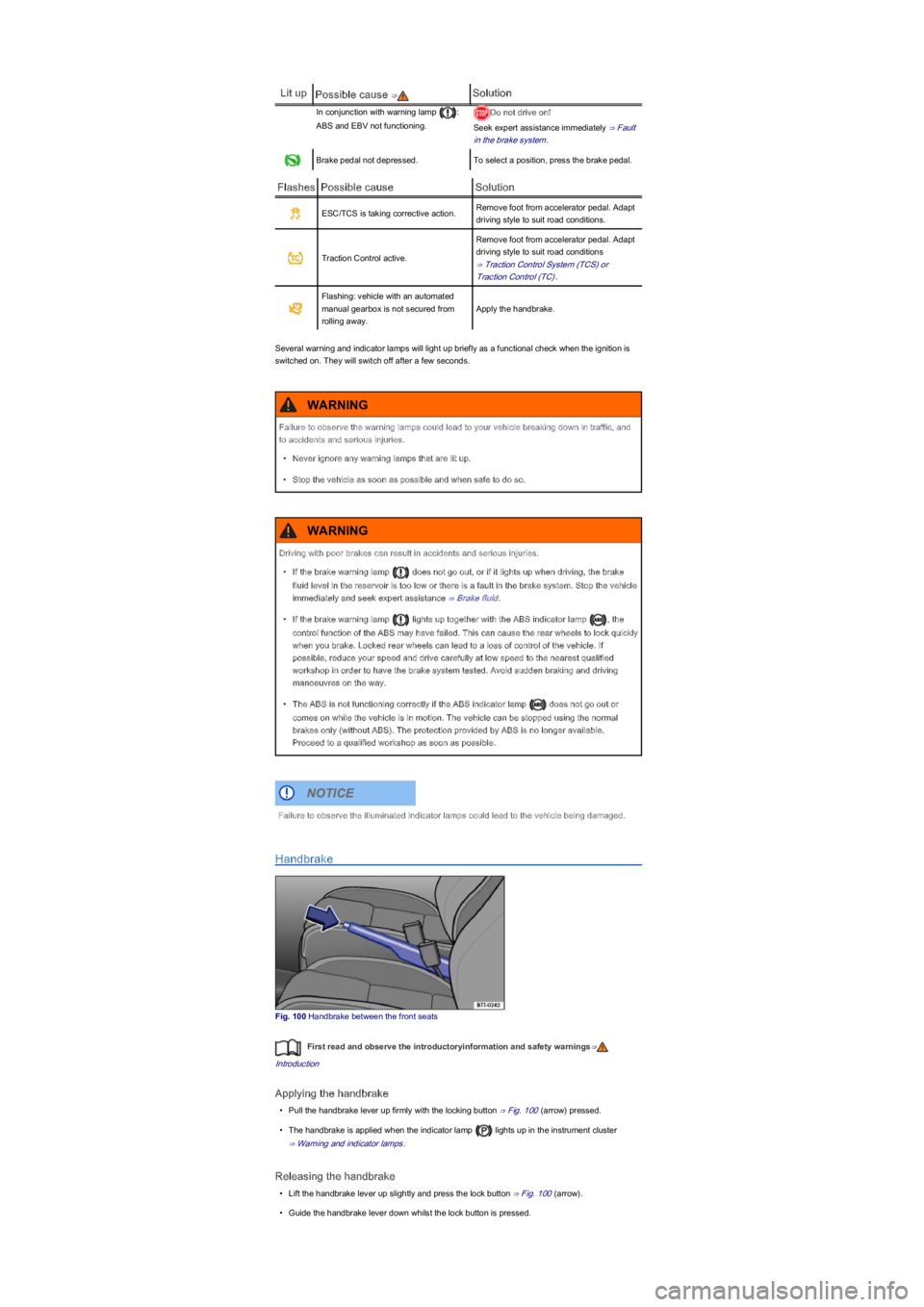
Lit upPossible cause ⇒Solution
In conjunction with warning lamp :
ABS and EBV not functioning.
Do not drive on!
Seek expert assistance immediately ⇒ Fault
in the brake system.
Brake pedal not depressed.To select a position, press the brake pedal.
FlashesPossible causeSolution
ESC/TCS is taking corrective action.Remove foot from accelerator pedal. Adapt
driving style to suit road conditions.
Traction Control active.
Remove foot from accelerator pedal. Adapt
driving style to suit road conditions
⇒ Traction Control System (TCS) or
Traction Control (TC).
Flashing: vehicle with an automated
manual gearbox is not secured from
rolling away.
Apply the handbrake.
Several warning and indicator lamps will light up briefly as a functional check when the ignition is
switched on. They will switch off after a few seconds.
Handbrake
Fig. 100 Handbrake between the front seats
First read and observe the introductoryinformation and safety warnings⇒
Introduction
Applying the handbrake
•Pull the handbrake lever up firmly with the locking button ⇒ Fig. 100 (arrow) pressed.
•The handbrake is applied when the indicator lamp lights up in the instrument cluster
⇒ Warning and indicator lamps.
Releasing the handbrake
•Lift the handbrake lever up slightly and press the lock button ⇒ Fig. 100 (arrow).
•Guide the handbrake lever down whilst the lock button is pressed.
Failure to observe the warning lamps could lead to your vehicle breaking down in traffic, and
to accidents and serious injuries.
•Never ignore any warning lamps that are lit up.
•Stop the vehicle as soon as possible and when safe to do so.
WARNING
Driving with poor brakes can result in accidents and serious injuries.
•If the brake warning lamp does not go out, or if it lights up when driving, the brake
fluid level in the reservoir is too low or there is a fault in the brake system. Stop the vehicle
immediately and seek expert assistance ⇒ Brake fluid.
•If the brake warning lamp lights up together with the ABS indicator lamp , the
control function of the ABS may have failed. This can cause the rear wheels to lock quickly
when you brake. Locked rear wheels can lead to a loss of control of the vehicle. If
possible, reduce your speed and drive carefully at low speed to the nearest qualified
workshop in order to have the brake system tested. Avoid sudden braking and driving
manoeuvres on the way.
•The ABS is not functioning correctly if the ABS indicator lamp does not go out or
comes on while the vehicle is in motion. The vehicle can be stopped using the normal
brakes only (without ABS). The protection provided by ABS is no longer available.
Proceed to a qualified workshop as soon as possible.
WARNING
Failure to observe the illuminated indicator lamps could lead to the vehicle being damaged.
NOTICE
Page 103 of 211
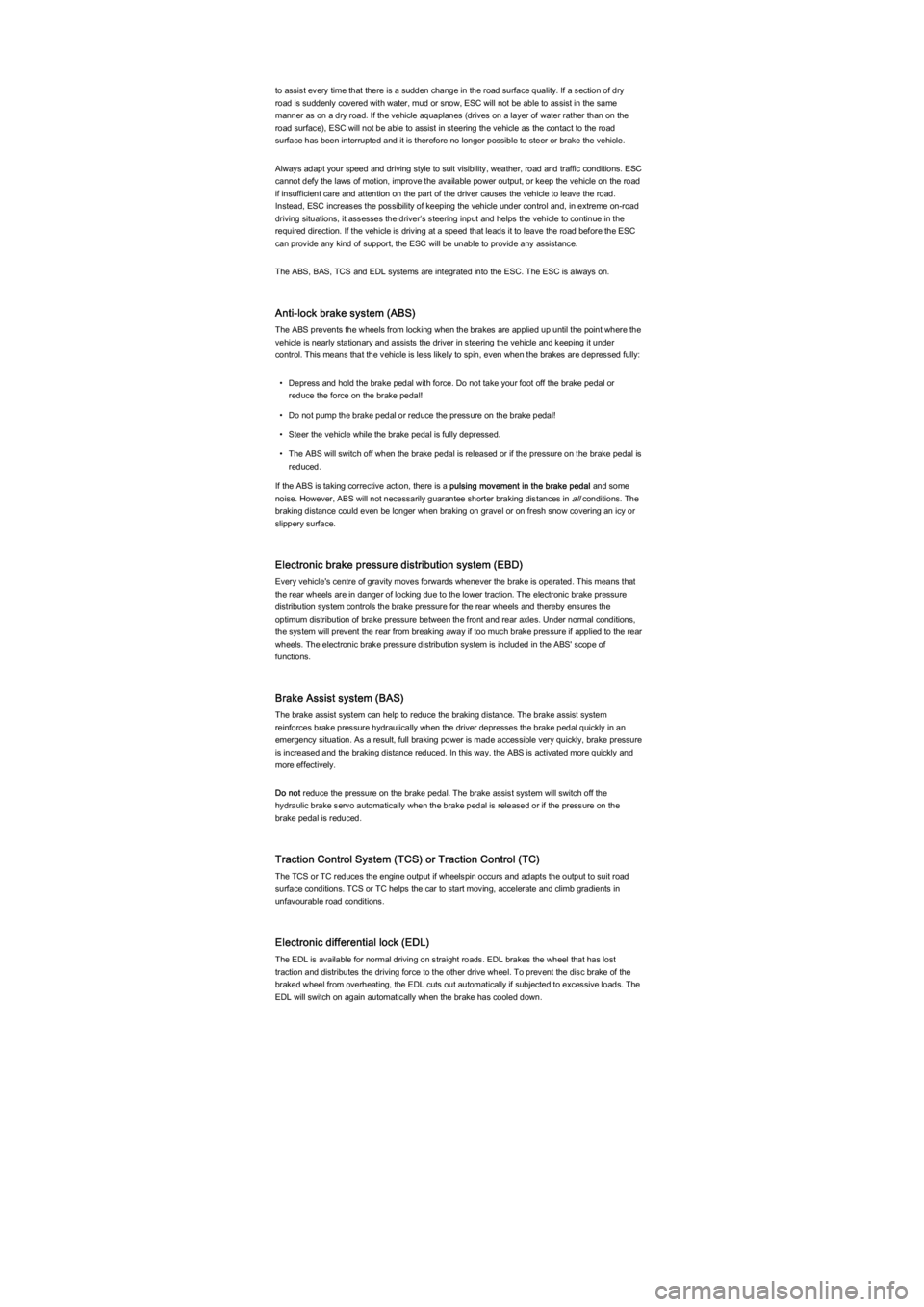
to assist every time that there is a sudden change in the road surface quality. If a section of dry
road is suddenly covered with water, mud or snow, ESC will not be able to assist in the same
manner as on a dry road. If the vehicle aquaplanes (drives on a layer of water rather than on the
road surface), ESC will not be able to assist in steering the vehicle as the contact to the road
surface has been interrupted and it is therefore no longer possible to steer or brake the vehicle.
Always adapt your speed and driving style to suit visibility, weather, road and traffic conditions. ESC
cannot defy the laws of motion, improve the available power output, or keep the vehicle on the road
if insufficient care and attention on the part of the driver causes the vehicle to leave the road.
Instead, ESC increases the possibility of keeping the vehicle under control and, in extreme on-road
driving situations, it assesses the driver’s steering input and helps the vehicle to continue in the
required direction. If the vehicle is driving at a speed that leads it to leave the road before the ESC
can provide any kind of support, the ESC will be unable to provide any assistance.
The ABS, BAS, TCS and EDL systems are integrated into the ESC. The ESC is always on.
Anti-lock brake system (ABS)
The ABS prevents the wheels from locking when the brakes are applied up until the point where the
vehicle is nearly stationary and assists the driver in steering the vehicle and keeping it under
control. This means that the vehicle is less likely to spin, even when the brakes are depressed fully:
•Depress and hold the brake pedal with force. Do not take your foot off the brake pedal or
reduce the force on the brake pedal!
•Do not pump the brake pedal or reduce the pressure on the brake pedal!
•Steer the vehicle while the brake pedal is fully depressed.
•The ABS will switch off when the brake pedal is released or if the pressure on the brake pedal is
reduced.
If the ABS is taking corrective action, there is a pulsing movement in the brake pedal and some
noise. However, ABS will not necessarily guarantee shorter braking distances in all conditions. The
braking distance could even be longer when braking on gravel or on fresh snow covering an icy or
slippery surface.
Electronic brake pressure distribution system (EBD)
Every vehicle's centre of gravity moves forwards whenever the brake is operated. This means that
the rear wheels are in danger of locking due to the lower traction. The electronic brake pressure
distribution system controls the brake pressure for the rear wheels and thereby ensures the
optimum distribution of brake pressure between the front and rear axles. Under normal conditions,
the system will prevent the rear from breaking away if too much brake pressure if applied to the rear
wheels. The electronic brake pressure distribution system is included in the ABS' scope of
functions.
Brake Assist system (BAS)
The brake assist system can help to reduce the braking distance. The brake assist system
reinforces brake pressure hydraulically when the driver depresses the brake pedal quickly in an
emergency situation. As a result, full braking power is made accessible very quickly, brake pressure
is increased and the braking distance reduced. In this way, the ABS is activated more quickly and
more effectively.
Do not reduce the pressure on the brake pedal. The brake assist system will switch off the
hydraulic brake servo automatically when the brake pedal is released or if the pressure on the
brake pedal is reduced.
Traction Control System (TCS) or Traction Control (TC)
The TCS or TC reduces the engine output if wheelspin occurs and adapts the output to suit road
surface conditions. TCS or TC helps the car to start moving, accelerate and climb gradients in
unfavourable road conditions.
Electronic differential lock (EDL)
The EDL is available for normal driving on straight roads. EDL brakes the wheel that has lost
traction and distributes the driving force to the other drive wheel. To prevent the disc brake of the
braked wheel from overheating, the EDL cuts out automatically if subjected to excessive loads. The
EDL will switch on again automatically when the brake has cooled down.